Sarajevo: Art , Culture and War
24 April, 2008, 01:06 am in "Bosnia and Herzegovina"
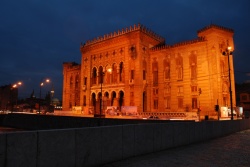 The train track to Sarajevo from Mostar follows along a river gorge with mountains of dark gray rock which were folded and layered like some kind of giant torte. The mountains were covered with a calico pattern of dark pine trees and light deciduous leaves. The tops were obscured by the clouds which looked like cobwebs waiting to be swept away by the sun. The jade green of the river was muted to more of a dusty lichen color. In the distance on the tops of the higher mountains, the rain had turned into snow.
The train track to Sarajevo from Mostar follows along a river gorge with mountains of dark gray rock which were folded and layered like some kind of giant torte. The mountains were covered with a calico pattern of dark pine trees and light deciduous leaves. The tops were obscured by the clouds which looked like cobwebs waiting to be swept away by the sun. The jade green of the river was muted to more of a dusty lichen color. In the distance on the tops of the higher mountains, the rain had turned into snow.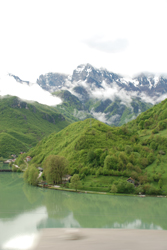
The towns were sparsely scattered houses, some new ones built right next to the ruins of the old. Sometimes, in large towns, huge identical concrete apartment buildings loomed over the other houses. It seems these artifacts of communist architecture managed to survive the war.
Our first impression of Sarajevo was... ugly. The location, surrounded by hills with a river (now brown) running through it was pretty, but it seemed to just be a sprawl of modern buildings and lots of concrete towers.
After lunch we went to the Tunnel Museum. The museum was the house of the Kolar family who had preserved artifacts from the war and the tunnel project. Edis and Bajro Kolar (father and son) had both been Bosnian soldiers at the time.
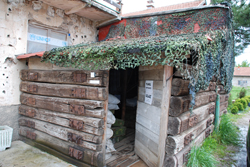
We were shown a video of Sarajevo during the war and what the residents had to try to live through. Then the video showed the construction of the Tunnel. The following information was gleaned from the museum brochure:
On April 15, 1992, the Yugoslavian Army and local Serbian militias began a siege on the city of Sarajevo. Water, electricity, communication and supplies were cut off. In July of 1992, the UN made an agreement with the Yugoslavian Army to take control of the airport in order to deliver humanitarian aide. Citizens tried to use the runways to escape from the city or reach supplies or communication channels but the UN would turn them back to the city if they were caught. Furthermore, while running through the fields and trenches, they were shot at by snipers. Close to 800 people were killed trying to bring food to their families, meet their loved ones, bring weapons for defense, or to escape to freedom from the hell of Sarajevo.
So, in the beginning of 1993, the Bosnian army and volunteers began to construct a tunnel to connect the city with the outside world. In July '93 it was finished. This tunnel stretched 800 meters and served as a lifeline for the people of Sarajevo: an oil pipeline, electric cable and food were passed through the tunnel... as well as 1000s of people. The tunnel kept many people of the town alive through the 2 remaining years of the siege following the tunnel's completion.
Under a structure next to the house is 5 meters of one end of the tunnel which is open to tourists. A large part of the tunnel collapsed under the airport runway but efforts are being made to restore the complete tunnel fully.
Although the tunnel itself wasn't the most fascinating thing to look at, it was definitely worth visiting something that was so instrumental in saving the lives of so many people.
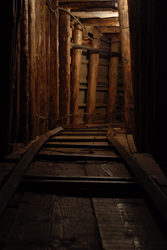
Once back in the center, we walked to the Ottoman quarter of town-- a pleasant pedestrian area with small shops selling... well... things you'd find in a Turkish bazaar. There were several mosques and a stone Ottoman market where the stalls had been replaced by shiny glass store fronts housing boutiques. There was also a quaint street where metal workers made hammered metal pieces like trays and cezves for Turkish coffee. They also made ornate pieces from old shells.
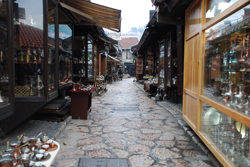
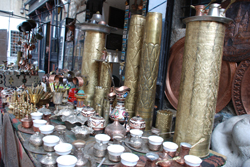
To my delight, there were numerous cafes and cake shops where a delicious piece of cake or baklava costs about 1 dollar and a shot of espresso, 75 cents. Though tempted to spend the whole day (especially since it was raining) sampling all the different cakes, we restrained ourselves and between downpours viewed the shelled ruins of the Old Town Hall (The National Library), the outside of the Gazi Husrev Bey Mosque, and the other sights in Bascarsiya, the Ottoman quarter.
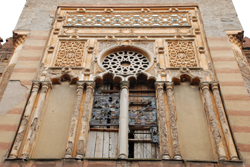
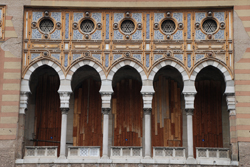
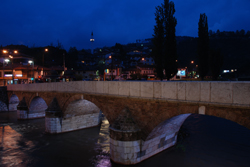
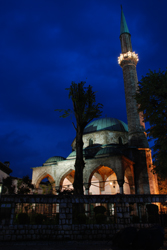
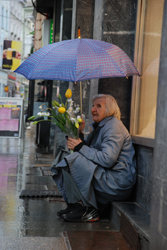
All this Ottoman stuff made us a bit homesick for Istanbul. So, since we found a good priced plane ticket to Istanbul, the next day we bought the last 2 seats on a 14:45 flight. We spent the rest of the morning wandering around the Ottoman quarter, having Turkish (Bosnian) coffee, and taking a walk to the fortress on the hill which over looks a graveyard full of white gravestones marking soldiers graves.
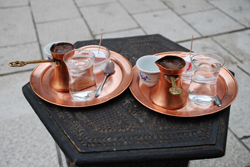
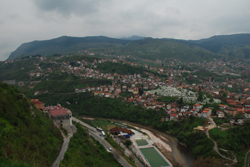
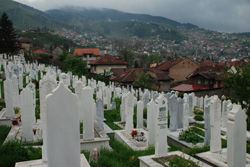
When we had walked into the center, we had come across a giant strawberry in front of the cathedral.
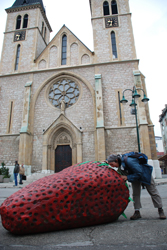
Walking back we came upon a giant orange in front of a WWII war memorial and later an apple in a park... none of which had been there the previous day.
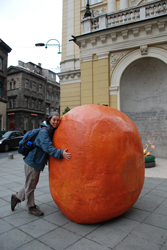
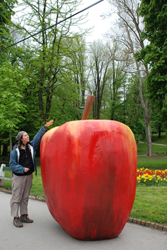
My favorite piece of Sarajevo art, though was a crazy human powered moving musical sculpture. There were pedals and wheels that when turned looked like they made metal ears flap and bellows blow air into giant horns. It looked like a lot of fun but the moving parts had been locked so the sculpture didn't work.
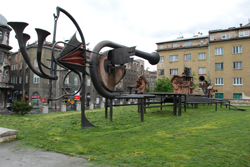
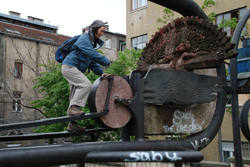
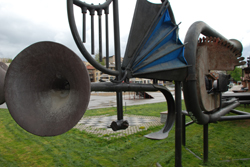
Bosnia is extremely proud of its multi-culturalism. We found a sculpture expressing this sentiment in a square. It was called "The Multicultural Man Builds the World".
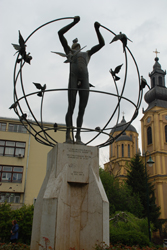
In the same square there was a giant chess game taking place.
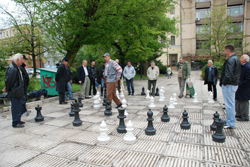
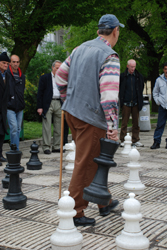
On a main pedestrian street we heard accordion music and saw the performer was one of 3 kids Rowshan had made friends with the night before.
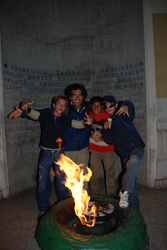
We listened a little and gave him 3 marks. His eyes widened in disbelief but he tried to hide the smile that was creeping across his lips. A little farther down, a little girl was singing gypsy songs. We gave her a mark. Ermin, the accordion player walked up and when I asked if she was his sister, he said yes. They happily disappeared down a street either for lunch or perhaps they had made their required amount for the day and were able to go play.
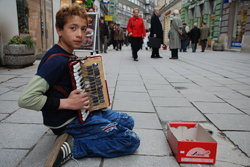
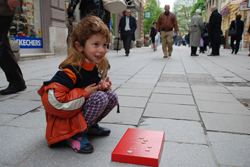
We collected our bags and hailed a taxi to the airport. The taxi driver was an older man playing a CD with old recordings of Bosnian music--75 to 100 years old he said. He said he was a musician and showed us a photo of his band on a business card.
We talked about how wonderful traditional music is. Rowshan played the driver some Bosnian songs from his Ipod and he was delighted. “Ah! I know this song. I play this!” He showed us a CD from his friend from Finland who is an ethnomusicologist. Soon we reached the airport. He said if we were ever in town again to call and we could play music together.
Comments
- Comments
Powered by My Blog 1.69. Copyright 2003-2006 FuzzyMonkey.net.
Created by the scripting wizards at FuzzyMonkey.net..
(Code modified by Rowshan Dowlatabadi)
Created by the scripting wizards at FuzzyMonkey.net..
(Code modified by Rowshan Dowlatabadi)

